|
Puerto Rican Parrot Amazona vittata Cotorra de Puerto Rico,
|
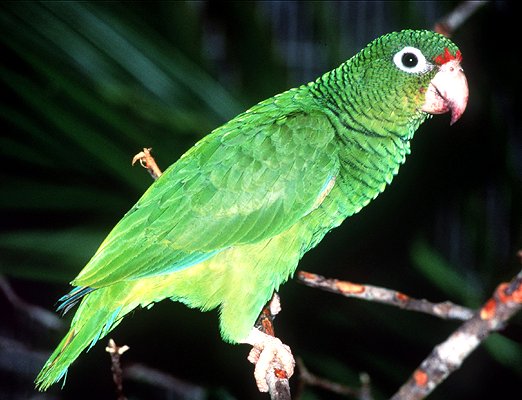 |
|
Photo: U.S. Fish & Wildlife Service*
|
|
Puerto Rican Parrot Amazona vittata Cotorra de Puerto Rico,
|
 |
|
Photo: U.S. Fish & Wildlife Service*
|
| IDENTIFICATION: A green parrot with a red forehead
and white eye ring. In flight the flight feathers flash a brilliant blue
color. Length: 30-33 cm.; weight: 250-300 g. The Hispaniolan
Parrot (Amazona ventralis; Cotorra de La Española) has
been introduced into the lowlands of Puerto Rico, and is often mistaken
for the Puerto Rican Parrot. It has a white instead of red forehead, and
a dark red belly.
VOICE: A distinctive bugling given in flight; a variety of squawks and squealing notes. Audio 3 (M. Oberle). HABITAT: Formerly found in all forest habitats in Puerto Rico, Vieques, and Culebra, but now restricted to mountain forests between 200-600 meters elevation on the west side of El Yunque (Caribbean National Forest). HABITS: The Puerto Rican Parrot travels in pairs or small flocks, and feeds on seeds and fruits, occasionally flowers. It eats the fruits, bark, or leaves of over 60 plant species. Important food trees in El Yunque are the sierra palm (Prestoea montana), and to a lesser extent the tabonuco tree (Dacryodes excelsa). Its nest is a cavity in a tree trunk, usually the palo colorado tree (Cyrilla racemiflora). Two to four eggs are laid from February to May. It has adapted to artificial nest cavities. The female incubates the eggs for 26 days, and the young fledge at about nine weeks of age. STATUS AND CONSERVATION: The Puerto Rican Parrot was formerly found on Vieques and Culebra. It also lived on the islands of Barbuda and Antigua as well, suggesting that this parrot ranged across the northern Lesser Antilles. This range reduction sadly illustrates a larger pattern: in all of the West Indies there were 50 to 60 species of endemic parrots, parakeets and macaws at about the time humans arrived. Since then all but 12 of those have become extinct. The Puerto Rican Parrot was common into the nineteenth Century, with a population of perhaps a million birds. The wild population declined to 13 individuals by 1975, and the species is on the Federal endangered species list. Habitat loss, hunting, and the pet trade contributed to the decline. Under aggressive protection, the population recovered to 45-47 birds but then dropped to 21-23 birds after Hurricane Hugo in 1989. In the two nesting seasons after Hurricane Hugo, a record number of young were produced. Although Hurricane Georges passed through El Yunque in 1998, the remaining wild population lived on the western side of El Yunque in valleys that were protected from the strongest winds. Thus, very few parrots were lost in that storm. Threats to the Puerto Rican Parrot include nest predation by Pearly-eyed Thrashers, Red-tailed Hawks and rats; loss of nest trees and food sources after hurricanes, bot fly infestations of young birds, and aggressive, Africanized bees taking over nest cavities. Aircraft are required to fly more than 2,000 feet above the ground over the Parrots’ breeding area to avoid disrupting nesting. Eventually, interbreeing with introduced parrot species may be a problem: exotic parrots have been seen in the current breeding area in El Yunque and near potential parrot release sites. Conservation measures include improving natural nest cavities by deepening them or adding drainage, or even providing artificial nest cavities. Sometimes providing a nest box for Pearly-eyed Thrashers near a parrot nest will reduce the chances that a thrasher will evict the parrots. After Hurricane Georges, 3 chicks were produced in the wild in 1999, and 17 in captivity (5 in Luquillo and 12 in Río Abajo) . In contrast, in 1998, 10 chicks were produced in the wild and 14 in captivity (4 in Luquillo and 10 in Río Abajo). The high productivity in the wild in 1998 may reflect abundant food sources, such as Sierra Palms, that had matured a decade after Hurricane Hugo. Female Hispaniolan Parrots are used as foster parents to raise Puerto Rican Parrot chicks in captivity. Captive-raised Hispaniolan Parrots were successfully released in the Dominican Republic in the late 1990s to work out the details of how to release captive-bred parrots into the wild. Ten captive-raised Puerto Rican Parrots were released in June 2000 into El Yunque, to join the current wild flock. An additional 16 were released in May 2001 and 9 in May 2002. Most of these released birds have survived. In early 2003 the population was several dozen birds in the wild, plus 134 in two captive populations at the Luquillo and Río Abajo aviaries. Although only about 15 wild birds were detected in the February 2003 census, an increasing number of sightings have been reported of Puerto Rican Parrots flying outside the census area, including foraging for food on private land outside the National Forest. So the wild population is almost certainly larger than the census results suggest. A second wild population of Puerto Rican Parrots may be established in the mountains of central Puerto Rico in the early 21st Century (perhaps 2004 or 2005) to reduce the chances that a single hurricane could wipe out as large a proportion of the wild population as did Hurricane Hugo. The current plan calls for parrots to be released initially near the Río Abajo aviary with the hopes that the birds that remain in the aviary will attract the released parrots and encourage them to remain in the local area rather than randomly disperse to areas where the chances of survival are low. RANGE: Endemic to Puerto Rico, the Puerto Rican Parrot is currently restricted in the wild to El Yunque and adjacent areas. The nesting area used by this species are closed to the public in order to protect the birds. Occasionally, parrots have been seen flying in late afternoon from the Tradewinds Trail, 1-2 miles west of PR 191, but that trail has frequently been closed due to landslides. They also have been seen recently flying over the Río Espíritu Santo overlook on PR 186. TAXONOMY: PSITTACIFORMES; PSITTACIDAE; Arinae. Also called the Puerto Rican Amazon. |
|
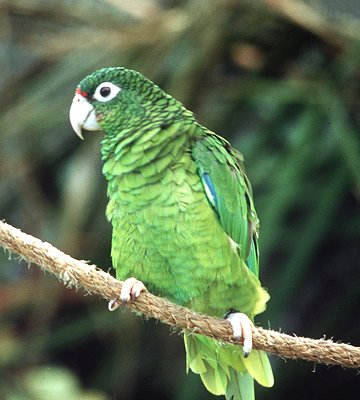 |
|
|
Photo: U.S. Fish & Wildlife Service*
|
 |
|
|
Photo: U.S. Fish & Wildlife Service
|
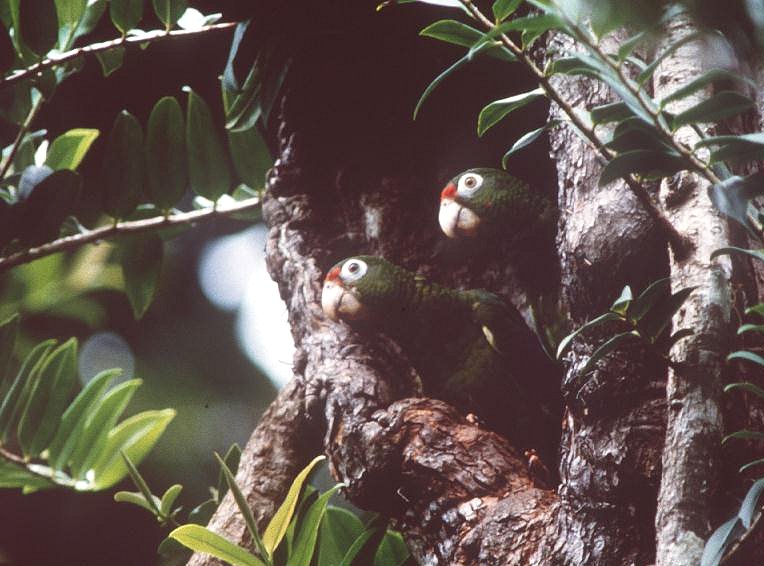 |
|
|
Photo: U.S. Fish & Wildlife Service
|
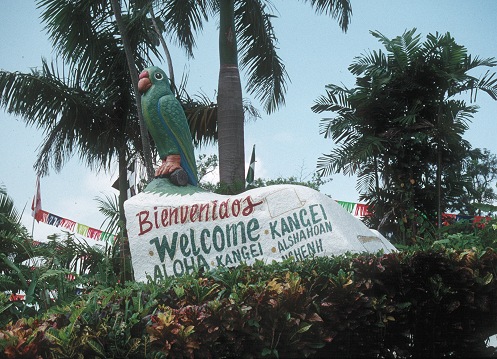 |
|
Photo: M. Oberle
|
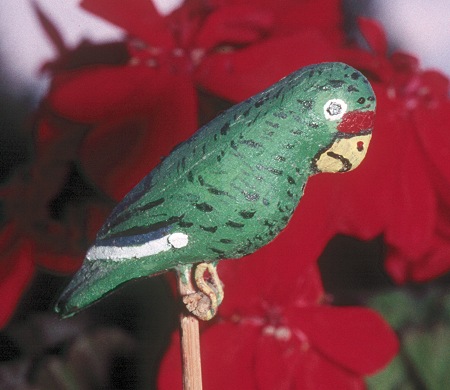 |
|
Folk art - Photo: M. Oberle
|
|
References BirdLife International. 2000. Threatened birds of the world. Lynx Edicions and BirdLife International, Barcelona and Cambridge, UK. Brock, M.K. and B.N. White. 1992. Application of DNA fingerprinting to the recovery program of the endangered Puerto Rican Parrot. Proc. Natl. Acad.Sci. USA 89:11121-11125. Collar, N.J., L.P. Gonzaga, N. Krabbe, A. Madronno Nieto, L.G. Naranjo, T.A. Parker III, and D.C Wege. 1992. Threatened birds of the Americas: The ICBP/IUCN red data book, 3rd edition, part 2. Smithsonian Institution Press, Washington, D.C. del Hoyo, J., A. Elliott, and J. Sargatal, eds. 1998. Handbook of the Birds of the World, Vol. 4. Sandgrouse to cuckoos. Lynx Edicions, Barcelona. Juniper, T. and M. Parr. 1998. Parrots: A guide to parrots of the world. Yale Univ. Press. Lindsey, G. D., W. J. Arendt, and J. Kalina. 1991. Home range and movements of juvenile Puerto Rican Parrots (Amazona vittata). J Wildlife Management 55:318-322. Lindsey, G. D. and W. J. Arendt. 1991. Radio tracking of Puerto Rican Parrots: assessing triangulation accuracy in an insular rain forest. Carib. J. Sci. 27:46-53. Lindsey, G.D. 1992. Nest guarding from observation blinds: strategy for improving Puerto Rican Parrot nest success. J Field Ornithol. 63(4):466-472. Meyers, J. M., F. J. Vilella, and W. C. Barrow, Jr. 1993. Positive effects of Hurricane Hugo: record years for Puerto Rican parrots nesting in the wild. Endangered Species Tech. Bull. 27:1-10 Meyers, J.M., W.J., Arendt, and G.D. Lindsey. 1996. Survival of radio-collared nestling Puerto Rican Parrots. Wilson Bull. 108:159-163. Myers, J. M. 1996. New nesting area of Puerto Rican Parrots. Wilson Bull. 108:164-166. Myers, J. M., W. J. Arendt, and G. D. Lindsey. 1996. Survival of radio-collared nestling Puerto Rican Parrots. Wilson Bull. 108:159-163. Raffaele, H.A. 1989. A guide to the birds of Puerto Rico and the Virgin Islands. Princeton. Raffaele, H.A. 1989. Una guía a las aves de Puerto Rico y las Islas Vírgenes. Publishing Resources, Inc., Santurce, PR. Raffaele, H.A., J.W. Wiley, O.H. Garrido, A.R. Keith, and J.I. Raffaele. 1998. Guide to the birds of the West Indies. Princeton. Scatena, F. N., and M. C. Larsen. 1991. Physical aspects of Hurricane Hugo in Puerto Rico. Biotropica 23:317-323. Snyder, N.F.R., J.W. Wiley, and C.B. Kepler. 1987. The parrots of Luquillo: natural history and conservation of the Puerto Rican Parrot. Western Foundation of Vertebrate Zoology, Los Angeles. Steadman, D. W. and M. I. Williams. in prep. New species and prehistoric records of parrots (Psittacidae) from the West Indies. Bulletin of the Florida Museum of Natural History. Vilella, F. J. and A. B. Arnizaut. 1994. Making the best of Mother Nature: Managing the Puerto Rican Parrot after Hurricane Hugo. Endangered Species Technical Bull. 19(2):10-11. Vilella, F. J. and E. R. Garcia. 1995. Post-hurricane management of the Puerto Rican Parrot. Pages 618-621 in J.A. Bissonette and P. R. Krausman, eds. Integrating people and wildlife for a sustainable future. Proceedings of the First International Wildlife Management Congress. The Wildlife Society, Bethesda, MD. Williams, M. I. and D. W. Steadman. 2001. The historic and prehistoric distribution of parrots (Psittacidae) in the West Indies. in Woods, C. A. and F. E. Sergile, eds. Biogeography of the West Indies: patterns and perspectives. 2nd Edition. CRC Press, Boca Raton, FL. www.crcpress.com Wiley, J. W. 1980. The Puerto Rican parrot (Amazona vittata): its decline and the program for its conservation. Pages 133-159 in R. E. Pasquier, ed. Conservation of new world parrots. International Council for Bird Preservation Tech. Publ. 1. Smithsonian Institution Press, Washington, DC. Wiley, J. W. 1991. Status and conservation of parrots and parakeets in the Greater Antilles, Bahama Islands, and Cayman Islands. Bird Conservation International. 1:187-214. Wilson, K. A., R. Field, and M. H. Wilson. 1995. Successful nesting behavior of Puerto Rican Parrots. Wilson Bull. 107:518-529. Wilson, K. A., M. H. Wilson, and R. Field. 1997. Behavior of Puerto Rican Parrots during failed nesting attempts. Wilson Bull. 109(3):490-503. Wright, T. F., C. A. Toft, E. Enkerlin-Hoeflich, J. Gonzalez-Elizondo, M. Albornoz, A. Rodríguez-Ferraro, F. Rojas-Suárez, V. Sanz, A. Trujillo, S. R. Beissinger, V. Berovides A., X. Gálvez A., A. T. Brice, K. Joyner, J. Eberhard, J. Gilardi, S. E. Koenig, S. Stoleson, P. Martuscelli, J. M. Meyers, K. Renton, A. M. Rodríguez, A. C. Sosa-Asanza, F. J. Vilella, and J. W. Wiley. 2001. Nest poaching in neotropical parrots. Conservation Biology 15(3):710-720. Wunderle, J. M., Jr. 1999. Pre- and post-hurricane fruit availability: implications for Puerto Rican Parrots in the Luquillo mountains. Carib J Science 35(3-4):249-264. Zwank, P.J. and B. J. Layton. 1989. Black Rats as potential Puerto Rican Parrot nest predators. Carib. J. Sci. 25:13-20. http://www.arndt-verlag.com/amazons.html http://southeast.fws.gov/prparrot/index.html http://biology.usgs.gov/s%2Bt/noframe/b016.htm
Puerto Rican Parrot, Spanish text Next related species in taxonomic order Previous related species in taxonomic order |